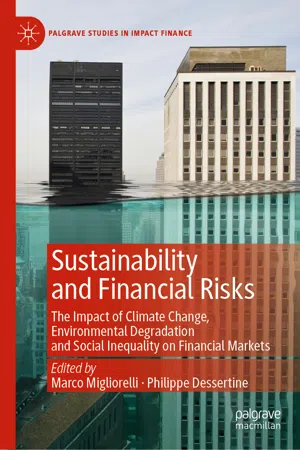The contents included in this chapter do not necessarily reflect the official opinion of the European Commission. Responsibility for the information and views expressed lies entirely with the author.
End Abstract1.1 Introduction
When it comes to the discussion on the relation between sustainability and finance, the policy and academic debate has been focused thus far on the possible role of the latter to support the transition towards a climate-neutral economy and a fairer society. In this respect, concepts and frameworks such as sustainable finance, green finance or climate finance have progressively emerged.1 These concepts and frameworks have also been consolidating within the financial industry in the form of new financial instruments (e.g. green bonds and sustainable funds), listing options (e.g. dedicated segments for sustainable securities in several stock exchanges worldwide), certification possibilities (e.g. green and climate labels for financial securities) or specific financing supporting initiatives (e.g. the World Bank or the European Investment Bank sustainability programmes). A new stream of literature is also progressively emerging dealing with these matters (e.g. Lehner 2016; Ziolo and Sergi 2019; Migliorelli and Dessertine 2019a).
Nevertheless, little attention has been given so far to the specific relationship linking sustainability and financial risks. That is, to the discussion on how factors such as climate change, environment degradation or social inequality, among others, can impact financial actors and markets. Indeed, this relationship, which is referred here as the sustainability-financial risk nexus, is of the utmost importance and may have systemic-wise consequences. For some observers, the failure of the various components of the financial industry to correctly integrate sustainability-related risks into financial risks frameworks may represent in the longer term a threat to the stability of the financial system as a whole (e.g. EC 2018a; BIS 2020).
To deepen the analysis on this issue, this chapter is structured as follows. First, Sect. 1.2 gives an overview of the role played nowadays by finance in fostering sustainability. To do that, the political and societal processes culminated with the adoption of the Sustainable Development Goals (SDG) and the signature of the Paris Agreement in 2015 are presented, as well as the expected contribution of finance in the resulting agendas. Then, Sect. 1.3 introduces the role of the sustainability-financial risk nexus within the general sustainable finance framework. In this respect, a review of the (scarce) literature dealing with this issue is also given. This dissertation is followed by Sect. 1.4, proposing a more comprehensive approach to the understanding of the relation between sustainability-related risks and financial risks. To this extent, a structured taxonomy linking the different types of risks is proposed. Finally, Sect. 1.5 concludes with a scrutiny of the key element of pricing of financial services when fully considering sustainability-related risks. Such an analysis includes the recognition of possible new market failures resulting from the progressive consolidation of these risks.
1.2 The Role of Finance in Fostering Sustainability
1.2.1 The Sustainable Development Goals (SDG) and the Paris Agreement
The concern of the sustainability of human activities have been discussed for decades (e.g. Renneboog et al. 2008; Berrou et al. 2019b). However, a significant acceleration in the political and societal debate has been observed only in the last few years. In this respect, the adoption of the Sustainable Development Goals (SDG) in September 2015 and the Paris Agreement2 reached in December of the same year landmarked a new era for the fight against climate change and the transition towards a sustainable economy.3
The SDG are part of the “2030 Agenda for Sustainable Development” adopted by the United Nations (UN) General Assembly. The Agenda is “a plan of action for people, planet and prosperity. It also seeks to strengthen universal peace in larger freedom” (UN
2015).
The SDG, to be achieved by 2030, have the merit to clearly identify the priorities of the international community in the attempt to reach a sustainable society, highlighting the importance of protecting the environment, of ensuring decent living conditions for all human beings and limiting the negative impacts of economic development. Table
1.1 reports the 17 SDG. In addition, 169 targets and 242 global indicators were also set to monitor the progress towards the realisation of the goals. In point of fact, the SDG reflect all the three distinctive dimensions of sustainable development: the economic, social and ecological dimensions. The wide acceptance of the SDG at the highest political levels represented with no doubt an important success and a significant step forward for the recognition of sustainability as one of key issues to be solved in the interest of humankind as whole.
Table 1.1Sustainable Development Goals (SDG)
# | Sustainable Development Goal | Short description |
|---|
SDG 1 | No poverty | End poverty in all its forms everywhere |
SDG 2 | Zero hunger | End hunger, achieve food security and improved... |
